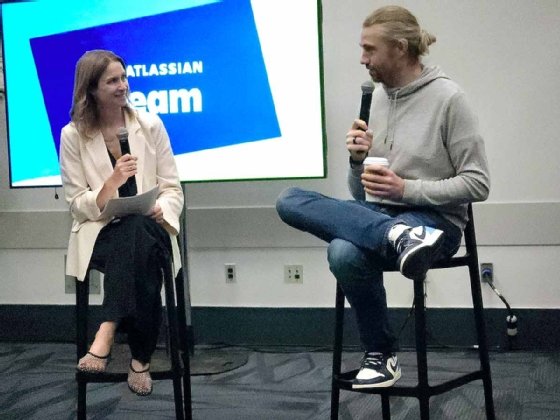
Getty Images/iStockphoto
Atlassian Rovo pricing shifts amid industry AI struggles
Atlassian's Rovo, including revamped Search and a new automation Studio, will be built into its cloud products as enterprises grapple with getting AI into production.
ANAHEIM, Calif. -- Atlassian's Rovo Search, Chat, Agents and a new Studio automation builder app will be built into its cloud products and subscription pricing as many enterprise AI initiatives are stymied by complexity and cost concerns.
When Atlassian Rovo first became generally available in October, it was priced at $24 per user, per month for companies with fewer than 100 users; and $20 per user, per month for 375 users, with sliding volume discounts as the number of users increased. Some Rovo Search features were available to non-Atlassian users at no additional cost. This week, the company revealed that Atlassian Rovo pricing will be baked into Premium and Enterprise cloud subscriptions in the coming weeks, and will be included in Standard versions later this year. Non-subscribers will now be charged a fee of $5 per user, per month.
Industry analysts view the change partly as a response to enterprises having difficulty determining a clear ROI for generative AI products.
"Customers were having a really tough time going back to executives and proving the business case for the additional costs that it would require to get the AI," said Julie Mohr, an analyst at Forrester Research. "They all thought it was fantastic, but there was this barrier. So, I think bundling it within, you know, some packaging or licensing capability is the smart way to go."
Atlassian cloud subscription prices also increased in October, between 5% and 18%, depending on the tier, number of users and whether they were billed monthly or annually. The company cited its R&D investments in the past two years as the reason for the change, including enterprise cloud security features, embedded Atlassian Intelligence capabilities, and the development of new products such as Atlassian Compass.
This likely also played a role in the decision to change Atlassian Rovo pricing, Mohr said.
"We started to hear a little bit from some of our clients how that was a shock to them -- Atlassian had not done that in the past," Mohr said. "[With] the general price increase, now bundling AI with it, [it] can counterbalance the cost."

Enterprises mired in AI growing pains, murky ROI
Atlassian officials at the Team '25 conference this week acknowledged that many enterprises are having a hard time getting AI initiatives into production -- the company's own State of Teams survey of 200 Fortune 1000 executives and 12,000 knowledge workers this year found that 71% of teams aren't using AI to help manage and discover corporate information, and 96% of executives aren't sure how to get teams to use AI more effectively.
During a press briefing, co-founder and CEO Mike Cannon-Brookes said that wasn't the case when asked if the pricing changes meant Atlassian Rovo adoption had been smaller than expected.
"I would say it's been one of our better, arguably best-performing launches," he said. "The decision there is really about … simplicity. When you have to buy everything individually … it got very difficult to explain to customers, 'A plus B gets this outcome; add C, you get this other outcome.'"
Cannon-Brookes said embedding features such as the newly revamped Rovo Search engine will boost the adoption of all Atlassian's products in the long run. Rolling out Rovo to more users will help Atlassian learn how to run the service cost-effectively at scale.
"We've started to test this with small-digit millions of people, and we are more confident we can run it with large-digit millions of people at a cost that's not going to kill us, which is one of the difficulties with AI," he said. "This stuff is not cheap … We're very confident in future cost reductions, which allow us to be maybe more ambitious in where we can and cannot include this."
Atlassian might be able to upsell customers on higher-level subscriptions as they increase their use of Rovo, which has usage limits according to pricing tier, according to Jamil Valliani, head of AI product for Atlassian, during a separate press briefing session this week.
One Rovo early adopter also sees cost benefits to integrating with the tools their company already uses, both from Atlassian and third-party vendors. The revamped Rovo Search unveiled this week, for example, includes 50 built-in connectors to third-party tools, including Google Workspace apps such as Google Docs.
"[There's] the price as in the cost of licenses, but also the costs of implementing [AI] integration," said Kasia Wakarecy, vice president of enterprise data and apps at Pythian, a data and analytics services company that partners with Google and uses both Google Gemini and Atlassian's Rovo.
"How many hours do I need to spend on connecting Rovo to third-party applications? Then there is day-to-day maintenance that I would need to do. Do we need to do extra work-around permission settings?" she said. "That's why we settled on Rovo, because it was easy to implement and part of a tool that the whole company is already using."
The 'blank canvas' factor
Cannon-Brookes and Valliani also cited the difficulty of getting started using AI as a motivating factor for more tightly integrating Rovo features with existing tools.
"Rollout takes a long time. Ready access to the tools is quite difficult, so they don't even have a chance to go try it," Valliani said. "It's not effectively woven into work -- for a lot of people, it's still this separate tool on the side."
The new Rovo Studio, introduced this week, is an example of how Atlassian is trying to help users understand what they can do with AI, he said. The new tool comes with built-in examples of actions a customized AI agent can perform, built-in examples of AI agents and AI assistants that suggest actions a customized agent can perform, and data sources to which it can connect based on a user's natural language prompt.
"We were watching our early Rovo customers building agents and trying to weave them into automation, and we saw people ranging from technical experts to folks who … have never built anything technical before," Valliani said. "And what we found is that blank canvas … can be really intimidating."
Valliani said Rovo Studio sets up "scaffolding" for AI agents so users can spend more time tailoring it to their specific needs, rather than trying to figure out how to fill a blank page.
One member of the early access program for the new Rovo features had to navigate the kind of slow rollout Valliani mentioned, but being able to experiment with Rovo Agents in a test environment helped demonstrate their value.
"We're heavily regulated, and there was red tape to get through before we even got to the proof of concept," said Fred Frenzel, director of the project management office at HarperCollins Publishers in New York. "We went through cyber, the AI board, legal, the trust team, and then finally got the approval to move from our sandbox environment to a POC in the production environment."
That allowed Frenzel to begin working with real data within a software product design and discovery workflow, starting with Jira Service Management feature requests and experimenting with how Rovo AI agents could help make the process more efficient.
"Using Rovo to help with first-draft creations for [features in response to requirements] was a huge accelerant to those teams to start focusing on strategy, as opposed to focusing on more of the overhead part of their job," he said.
A Rovo Agent also helped summarize the project discovery process with a TL;DR for leaders to evaluate for approval and move into product delivery, Frenzel said. Similarly, meeting summaries can now directly generate Jira tickets based on action items.
Confronting the AI skills gap
Frenzel and Wakarecy both described a learning curve around prompting Rovo Agents and achieving desired outcomes from Rovo Search. For example, Frenzel said he had difficulty getting Rovo Agents to analyze his team's entire Jira backlog. Rovo Agents were limited in the number of sequential actions they would perform during his tests.
"There were a certain amount of triggers that you could do to a Jira ticket itself, [but] I would ask it for everything -- to comment, to update a status, update these four or five different fields, move it into a sprint, progress it through to the sprint, and then also notify someone at the same time," he said. "It couldn't do all those things."
Users at Pythian had a similar experience. Rovo Agents would initially look only at a limited number of tickets, but with proper prompt engineering, they were able to force the system to return more results, Wakarecy said. Pythian users also went through a similar learning curve when prompting Rovo Search to optimize results.
Wakarecy said she'd like to see Atlassian add tools for admins that track prompts and responses to help improve queries for Rovo. Rovo Search and Agents have audit logs that track activity, and users can ask Rovo to show how it came to a particular response, but "another person cannot come back a week later and say, 'Show me all of the queries that were performed, and show me all of the results,'" she said.
Valliani was asked during the press briefing about whether Atlassian plans to add observability tools for admins to evaluate the success of AI tool rollouts and usage. He said the company plans to invest in more dashboards.
Beth Pariseau, senior news writer for Informa TechTarget, is an award-winning veteran of IT journalism covering DevOps. Have a tip? Email her or reach out @PariseauTT.







